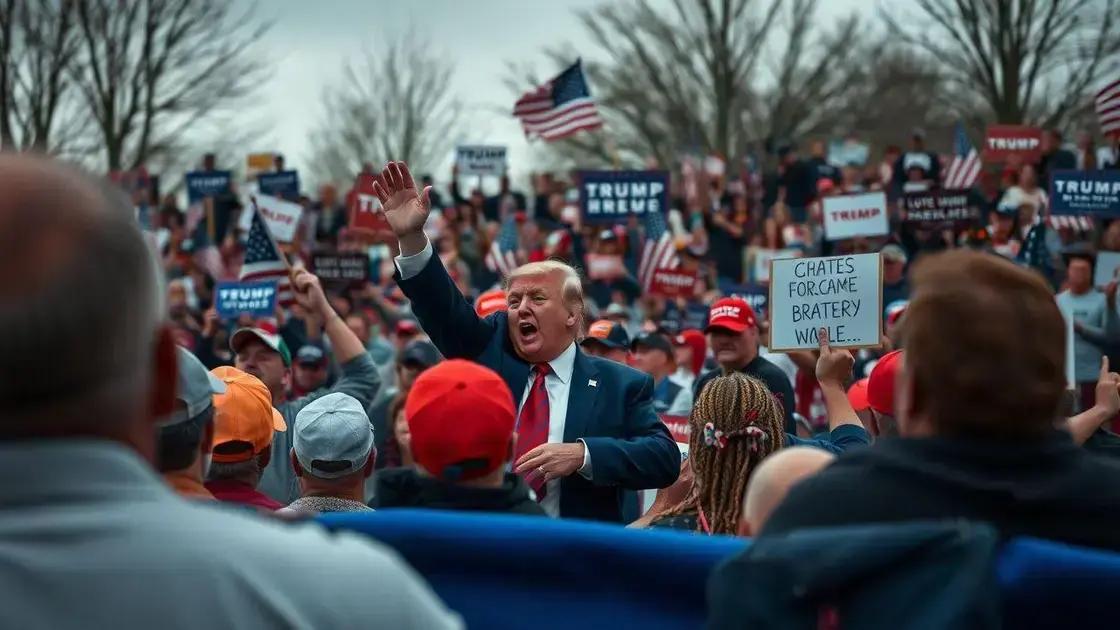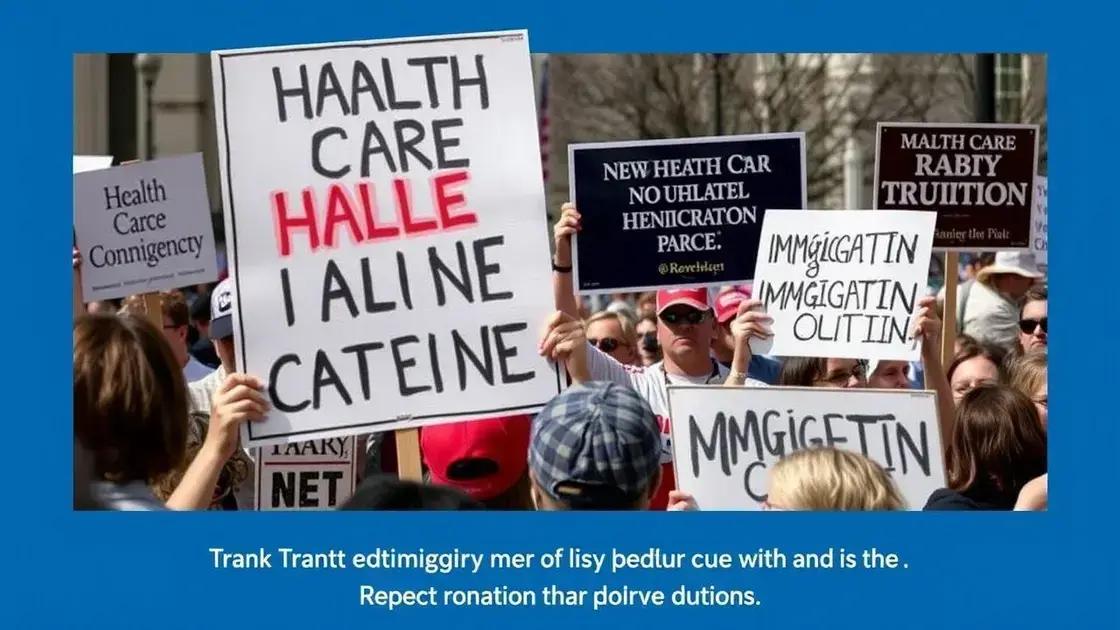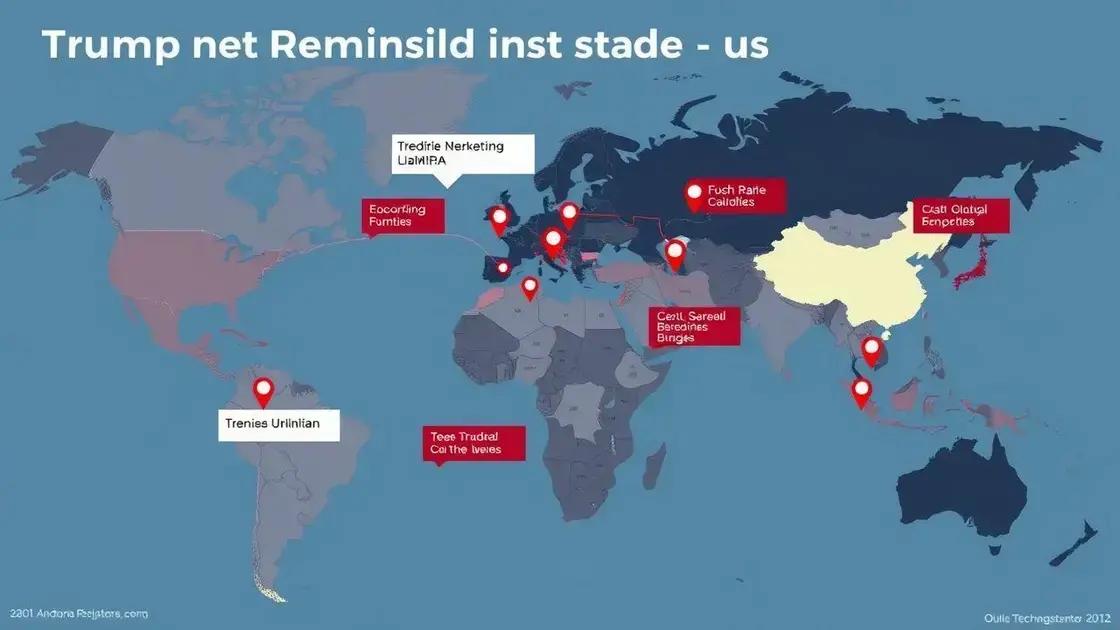Trump administration controversies that shaped politics

The Trump administration was marked by controversies including immigration policies, trade negotiations, and impeachment, leading to significant political polarization and lasting impacts on American politics and international relations.
Trump administration controversies defined a turbulent period in U.S. history. From policy disputes to public reactions, these controversies shaped political discourse in ways we still feel today. Curious about the details?
Key moments of the Trump administration
The Trump administration was marked by several key moments that changed the political landscape in America. From bold policy changes to significant events, each moment shaped perceptions and decisions across the nation.
Major Events of the Administration
One of the most notable key moments was the implementation of the Travel Ban. Introduced early in Trump’s presidency, this controversial policy restricted entry for citizens from several predominantly Muslim countries. It sparked widespread protests and legal battles, highlighting the divisions in public opinion.
Another defining moment was the impeachment of Donald Trump. The first impeachment stemmed from allegations of abuse of power involving Ukraine. This unprecedented event showcased deep political polarization and became a focal point of national discourse.
Tax reform also played a significant role during this period. The Tax Cuts and Jobs Act aimed to stimulate economic growth by reducing corporate tax rates. Supporters claimed it would lead to job creation, while critics argued it favored the wealthy and increased the deficit.
Public Reactions
- Protests and rallies erupted in response to the Travel Ban.
- The impeachment process led to heightened media coverage and public debate.
- Many citizens felt the effects of tax reform in their paychecks.
Additionally, the administration’s response to the COVID-19 pandemic became a key moment. Early reactions were met with mixed criticism, as the nation struggled to balance health concerns and economic impacts. The distribution of vaccines at the end of Trump’s term offered a partial resolution to the crisis.
The Trump administration also dealt with pivotal issues regarding climate change. Decisions to withdraw from the Paris Agreement raised questions about America’s commitment to global environmental efforts.
These moments, among many others, illustrate the significant impact of Trump’s presidency. As debates about his legacy continue, understanding these key events helps clarify the current political climate in the U.S.
Major policy controversies

Throughout the Trump administration, various major policy controversies emerged that sparked intense debate and public scrutiny. These controversies not only defined his presidency but also influenced public opinion and political discourse in America.
Healthcare Policies
One of the major controversies was the attempt to repeal the Affordable Care Act (ACA). The administration sought to dismantle key provisions of the ACA, which provided millions with health insurance. Critics argued that this would leave many vulnerable individuals without access to essential healthcare services.
Another significant issue was the administration’s approach to drug pricing. Proposals aimed to lower prescription drug costs faced pushback from pharmaceutical companies, raising questions about how to balance affordability and innovation.
Immigration Policies
Immigration policy became a heated topic during Trump’s time in office. The push for stricter immigration laws included measures such as family separations at the border. This policy drew widespread condemnation from human rights groups and the public.
Another controversial move was the attempt to end the Deferred Action for Childhood Arrivals (DACA) program. This program protected young immigrants brought to the U.S. as children from deportation. Many viewed the move as heartless, sparking protests across the country.
Trade policies also stirred debate. The imposition of tariffs on countries like China led to fears of a trade war, affecting businesses and consumers alike. Supporters claimed it protected American jobs, while critics argued it would lead to higher prices for everyday goods.
Additionally, the handling of environmental regulations drew criticism. The decision to roll back regulations aimed at protecting clean air and water raised alarms about the implications for public health and the environment. Many activists argued that these decisions prioritized industry over the well-being of citizens.
These major policy controversies reveal the contentious nature of Trump’s presidency and its lasting effects on American politics. As the nation continues to grapple with these issues, understanding these controversies is vital for navigating the current political landscape.
Public response to Trump’s decisions
The public response to Trump’s decisions was often highly polarized, reflecting deep divisions within American society. Many people strongly supported some of his initiatives, while others vehemently opposed them.
Support for Immigration Policies
Supporters of Trump’s immigration policies often argued that they were necessary for national security. For them, measures like the border wall and travel bans were seen as efforts to protect American jobs and resources. Some felt these policies brought order to immigration and enhanced public safety.
On the other hand, many citizens and advocacy groups protested against these policies. They believed that the administration’s actions were inhumane and discriminatory. Family separations at the border triggered outrage and led to mass protests, showing how deeply people cared about the treatment of immigrants.
Economic Decisions and their Impact
Trump’s economic decisions also sparked varied reactions. His tax reforms received praise from business owners who felt that lower corporate taxes would lead to growth. Many reported increased investments and hiring practices as a result.
- Supporters highlighted the boost in stock markets.
- Critics pointed out increasing income inequality.
- Some argued the benefits were not reaching the working class.
As the public tried to navigate through different perspectives, the response to economic policies remained mixed. Many wanted clarity on how these decisions affected their lives.
Additionally, Trump’s handling of the COVID-19 pandemic was a significant flashpoint. Early actions, including public health messaging, received criticism. Many felt that the response was slow and insufficient, leading to confusion and distrust.
However, the rapid development and distribution of vaccines towards the end of his term were seen positively by some. Supporters credited his administration with accelerating vaccine development through Operation Warp Speed. This dichotomy showed how public perception could shift based on outcomes and their impacts on daily lives.
In short, the public response to Trump’s decisions revealed a complex landscape of opinions and emotions. Understanding this varied response is essential in evaluating the overall impact of his presidency.
Impact on international relations

The impact on international relations during the Trump administration was significant and multifaceted. His approach marked a departure from previous U.S. foreign policy and had lasting effects on global alliances.
Trade Relationships
One of the most notable changes was in trade policy. Trump prioritized ‘America First’, leading to the renegotiation of key trade agreements. The new United States-Mexico-Canada Agreement (USMCA) replaced NAFTA and aimed to better protect American jobs. Supporters claimed it benefited U.S. workers, while critics argued it could strain relations with neighboring countries.
Relations with China
The relationship with China evolved dramatically under Trump. The administration imposed tariffs on Chinese goods in an attempt to address trade imbalances. This action sparked a trade war, leading to retaliatory measures from China. Many argued it hurt American consumers and farmers.
- Increased prices on imported goods affected everyday consumers.
- Some American farmers faced reduced exports to China.
- However, some industries benefitted from reduced competition.
This trading tension created uncertainty in global markets and highlighted the interconnectedness of world economies.
Alliances and NATO
Trump’s presidency also saw a shift in traditional alliances. He frequently criticized NATO members for not meeting defense spending commitments, raising questions about American commitment to allied nations. His approach led to strained relationships with long-standing partners and prompted discussions about the future of security collaborations.
Moreover, Trump’s outreach to leaders like North Korea’s Kim Jong-un was unprecedented. Meetings aimed at denuclearization produced mixed reactions. Some viewed it as a step towards peace, while others were skeptical of its effectiveness.
The withdrawal from international agreements, such as the Paris Climate Accord, signaled a retreat from multilateralism. Critics warned this could undermine global efforts to combat climate change and lead to isolationism.
Overall, the impact on international relations during the Trump administration reshaped how the U.S. engaged with the world. As alliances shifted and new policies emerged, the global landscape faced uncertainty and challenges.
Legal challenges faced by the administration
The legal challenges faced by the Trump administration were numerous and varied, reflecting the contentious nature of his presidency. From executive orders to impeachment trials, legal battles shaped the course of his time in office.
Immigration Policies and Legal Battles
One significant area of legal contention was the administration’s immigration policies. The Travel Ban, which restricted entry from several majority-Muslim countries, faced immediate legal challenges. Multiple federal courts ruled against the ban, arguing it was unconstitutional and discriminatory.
Additionally, attempts to end the Deferred Action for Childhood Arrivals (DACA) program sparked lawsuits from states and advocacy groups. Ultimately, the Supreme Court ruled against the administration’s efforts to terminate DACA, reinforcing protections for young immigrants.
Environmental Regulations
Legal challenges also arose from the administration’s efforts to roll back environmental regulations. Several states and environmental organizations filed lawsuits against various policies, claiming they violated federal laws and endangered public health. One notable case involved the rollback of the Clean Power Plan, which aimed to reduce carbon emissions from power plants.
- Critics argued these rollbacks prioritized corporate interests over the environment.
- Numerous lawsuits aimed to hold the administration accountable for environmental protections.
- These cases highlighted the ongoing battle between federal and state authority.
The administration also faced scrutiny regarding its handling of the COVID-19 pandemic. Legal challenges arose concerning the administration’s public health responses and the distribution of funds for pandemic relief. Some states challenged federal directives, arguing they limited their ability to respond to the crisis effectively.
Impeachment was perhaps the most notable legal challenge. The House of Representatives impeached Trump twice, once in 2019 for abuse of power and obstruction of Congress, and again in 2021 for incitement of insurrection related to the Capitol riots. Both impeachments led to lengthy trials in the Senate, with Trump ultimately acquitted both times.
The legal challenges faced by the Trump administration underscore the contentious nature of his presidency. Whether through immigration, environmental policies, or impeachment, the legal landscape was a significant aspect that defined his time in office.
Lasting effects on American politics

The lasting effects on American politics from the Trump administration are profound and continue to influence the political landscape today. His presidency reshaped many aspects of governance, party dynamics, and public discourse.
Political Polarization
One of the most significant effects is the increased political polarization. Under Trump, political parties became more divided, with strong tribalism among supporters. This division extended beyond party lines, affecting social interactions and community dynamics.
Many Americans began identifying more strongly with their political affiliations, leading to challenges in bipartisan cooperation. Issues that could once garner cross-party support became contentious, making it difficult to pass significant legislation.
Shift in Republican Party Identity
The Republican Party also underwent a noticeable transformation. Trump’s populist approach and focus on nationalism appealed to a broad base, shifting the party’s identity. Traditional conservative values were often overshadowed by a focus on loyalty to Trump himself.
- This shift attracted new voters while alienating some long-time conservatives.
- Debates around issues like immigration and trade saw more hardline positions.
- The party’s strategies now frequently emphasize culture wars over policy debate.
The impact on party identity has led to a reevaluation of what it means to be a Republican in the modern era.
Influence on Future Elections
Trump’s presidency also set the stage for future elections. He mobilized a passionate base that remains influential. Many candidates vying for office feel pressure to align with his policies and rhetoric to gain support. This influences their campaign strategies and voter appeal.
Moreover, Trump’s approach to communication through social media changed the landscape of political campaigning. The emphasis on direct communication with constituents has forced candidates to engage differently. They must navigate misinformation and crowd-sourced platforms while attempting to present their messages clearly.
The repercussions of his presidency are evident in ongoing debates about democracy and governance. Issues surrounding election integrity and voting rights have come to the forefront, reflecting Trump’s impact on public perception and policy priorities.
As the political party structures continue to evolve, the lasting effects of the Trump administration remind us that the roots of political and social change often run deep.
The Trump administration brought significant changes and controversies to American politics. Its impact can still be felt today as debates about policies, political identity, and international relations continue. From heightened political polarization to shifts in party dynamics, Trump’s presidency changed how Americans view governance. The influence of his decisions will likely shape the future of elections and political discourse for years to come. Understanding these lasting effects is essential for Americans as they navigate an evolving political landscape.
FAQ – Frequently Asked Questions about Trump Administration Controversies
What were some key policies of the Trump administration?
Key policies included immigration reform, tax cuts, and trade negotiations, all of which sparked significant public debate and legal challenges.
How did Trump’s presidency affect political polarization?
Trump’s presidency intensified political polarization, leading to greater division between parties and increasing tensions among the public.
What impact did Trump have on international relations?
Trump’s administration reshaped international relations through trade tariffs, withdrawal from agreements like the Paris Accord, and direct engagement with North Korea.
What were the lasting effects of Trump’s presidency on American politics?
Lasting effects include shifts in party identity, changes in public discourse, and a mobilized voter base that continues to influence elections.






